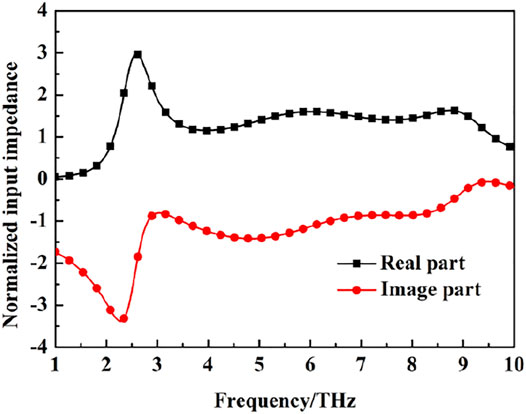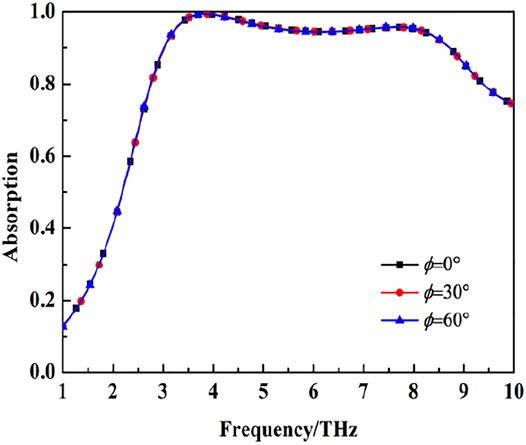- 1Science and Technology Department, Sanya University, Sanya, China
- 2Finance and Economics Department, Sanya University, Sanya, China
- 3Science Department, Northwestern Polytechnical University Xi’an, Shanxi, China
In this paper, we report a switchable ultra-wideband metamaterial absorber with polarization-insensitivity and wide-incident angle at THz band which is composed of VO2 disk, polyimide dielectric substrate, and gold ground plane. The results show that the absorption is greater than 90% from 3.5–8 THz for a temperature of 300 K and this absorption band disappears when the temperature rises to 350 K. The absorption property of our proposed metamaterial absorber is insensitive to polarization states and angles and it can withhold high absorption of more than 80% for wide-incident angles, up to 60° for TE mode and TM mode. The wideband absorption mechanism is elucidated using an effective medium and surface current analysis.
Introduction
Absorbing materials refer to natural materials or metamaterials constructed by electromagnetic structures that can absorb electromagnetic waves in free space. Traditional absorbing material is a kind of absorbing material coated on the target surface, which is usually made of ferrite, carbon powder, and other absorbents mixed with some non-metallic substrates such as thermoplastic or epoxy resin. The traditional absorbing material usually has the disadvantage of having a narrow absorption band, small absorption angle and being bulky. In 2008, Landy et al. (Landy et al., 2008) firstly proposed the concept of metamaterial absorber. Since then, metamaterial absorber has attracted wide attention. Many researchers have achieved excellent results on wideband absorption, polarization-insensitivity, tunable absorption, and so on from microwave to the visible light band (Chen, 2012; Wang et al., 2014a;; Hao et al., 2014; Chen et al., 2015; Lin et al., 2016; Chen et al., 2019; Xie et al., 2019; Zhang et al., 2019; Zheng et al., 2019; Quader et al., 2020; Zhang et al., 2021). At present, the researches of metamaterial absorber are flourishing to achieve wideband absorption, polarization-insensitive absorption, tunable absorption, and multi-band absorption (Aydin et al., 2011; Li et al., 2011; Ding et al., 2012; Xu et al., 2012; Argyropoulos et al., 2013). However, the narrow-incident angle of metamaterial absorbers limit their applications in practice. Consequently, it is necessary to design metamaterial absorbers with polarization-insensitivity and wide-incident angle.
Many methods have been devoted to widen the incident angle of metamaterial absorbers. In 2017, Fan J X et al. proposed a wide-angle wideband terahertz metamaterial absorber with a multilayered heterostructure (Fan et al., 2017). In 2018, Huang X T et al. designed a wide-angle perfect metamaterial absorber based on cave-rings and the complementary patterns (Huang et al., 2018a), its absorption is over 92% at around 6.53 THz when the incident angle for the TE mode is up to 80°, and at TM mode, its absorption at 7.64 THz is greater than 92% even for an incident angle of up to 70°. In the same year, Huang X T designed multiband ultrathin polarization-insensitive terahertz perfect absorber (Huang et al., 2018b), it presented the ability to maintain high absorption of more than 80% for a large incident angle up to 60° for both TE and TM modes.
However, the absorption band of the above mentioned wide-angle terahertz metamaterial absorber is narrow, this limits their application in practice. In this work, we propose a switchable ultra-wideband metamaterial absorber with polarization-insensitivity and wide-incident angle at the THz band. Its absorption is over 90% from 3.5–8 THz for a temperature of 300 K and the absorption band fades away when the temperature rises to 350 K. It remains highly absorptive with over 80% absorption for a wide-incident angle up to at 60°for both TE mode and TM mode. Compared with the reported wide-angle terahertz wideband metamaterial absorber (He et al., 2011; Wang et al., 2014b; Li et al., 2015; Huang et al., 2018c; Dinh et al., 2021), our designed metamaterial absorber has the advantages of wider absorption bandwidth and incident angle.
Model Design
As illustrated in Figure 1, the unit cell of our proposed metamaterial absorber consists of VO2 disk, polyimide dielectric substrate, and gold ground plane. The periodicities of the unit cell are a = b = 12 μm. The geometrical parameter of the VO2 disk is r = 5 μm. During the simulation process, the VO2 disk is set as a thermally tunable resistance film material with the conductivity
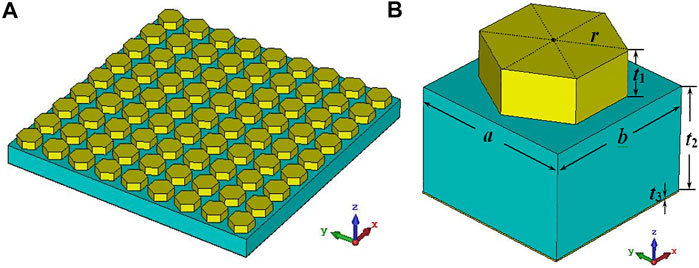
FIGURE 1. Schematic diagram of the metamaterial absorber unit cell, (A) 9 × 9 array of the unit cell, (B) perspective view of the unit cell.
The full-wave electromagnetic simulation of our proposed metamaterial absorber is performed with CST Microwave Studio. Throughout the simulation process, the boundary conditions of x and y directions are set as unit cell, the z-direction is set as open. All + Floquet ports are used to simulate the incoming and outgoing waves. The electromagnetic parameters are calculated using a frequency-domain electromagnetic solver.
Results and Discussion
For the metamaterial absorber, the absorption can be calculated by
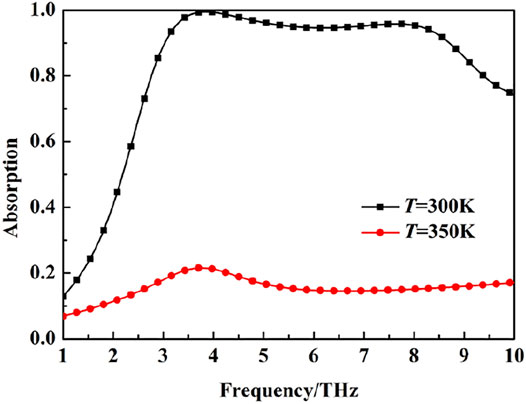
FIGURE 2. The absorption of the metamaterial absorber under the temperatures T = 300 K and T = 350 K
To understand the absorption mechanism, the normalized input impedance of the metamaterial absorber with the free space for normal incidence (T = 300 K) is retrieved from the simulated
The wideband absorption mechanism of the proposed metamaterial absorber is further clarified in Figure 4. Figure 4 shows the surface current of the metamaterial absorber on the VO2 disk and gold ground plane at 6 THz (T = 300 K). It can be seen that the induced anti-parallel currents on these two layers prove that magnetic resonance is formed at 6 THz. Therefore, the absorption of the metamaterial absorber at 6 THz originates from the magnetic resonance (Son et al., 2014). The reason for wideband absorption is that the circuit resonant structure formed by VO2 disk, polyimide dielectric substrate, and a gold ground plane can realize the impedance match between the metamaterial absorber and free space over a wide frequency range near the resonant frequency, and can then broaden the absorption band (Costa et al., 2010; Zhang et al., 2013).
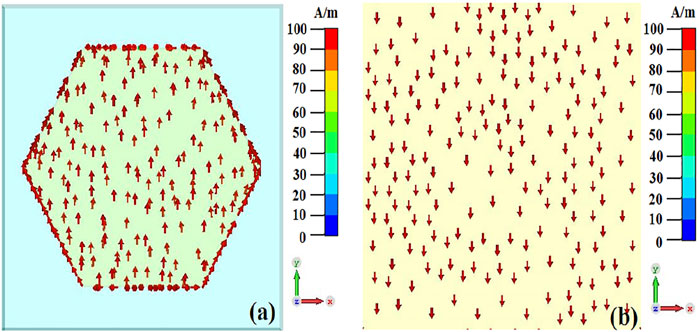
FIGURE 4. The surface current of the metamaterial absorber at 6 THz (T = 300 K), (A) VO2 disk; (B) gold ground.
The power loss density distributions at different frequencies are monitored at T = 300K, as shown in Figure 5. It can be observed that there are similar power loss density distributions at different frequencies at 4 and 6 THz, the power losses all concentrate on the front part of polyimide dielectric substrates.

FIGURE 5. The power loss density distribution of the metamaterial absorber (T = 300 K), (A) 4 THz, (B) 6 THz.
Figure 6 shows the absorption of the metamaterial absorber at different polarization angles (T = 300 K). Owing to the rotational symmetry of the unit cell, the absorption under different polarization angles is the same.
The waves are usually incident on to metamaterial absorber with different incident angles. Figure 7 shows the absorption of the metamaterial absorber with different incident angles at TE and TM mode (T = 300 K). For TE and TM mode, the absorption is over 80% for incident angles below 60° from 3.5–8 THz. However, the absorption decreases noticeably for incident angles beyond 60°. This indicates that the absorption property of the metamaterial absorber has the advantage of being responsive towards wide-incident angle.
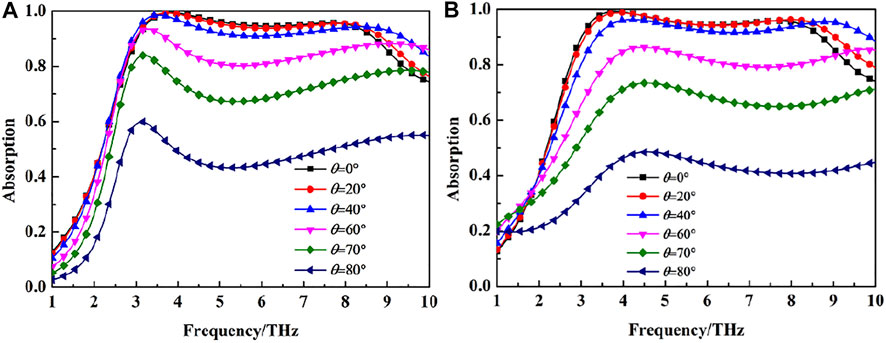
FIGURE 7. The absorption of the metamaterial absorber at different incident angles (T = 300 K), (A) TE mode, (B) TM mode.
Figure 8 and Figure 9 shows the absorption of the metamaterial absorber for different thickness of VO2 disk and polyimide dielectric substrate (T = 300 K). The absorption band of the metamaterial absorber gradually shifts to a higher frequency with the increase of thickness of VO2 disk. The absorption of the metamaterial absorber gradually decreases with the increase of the thickness of the polyimide dielectric substrate.
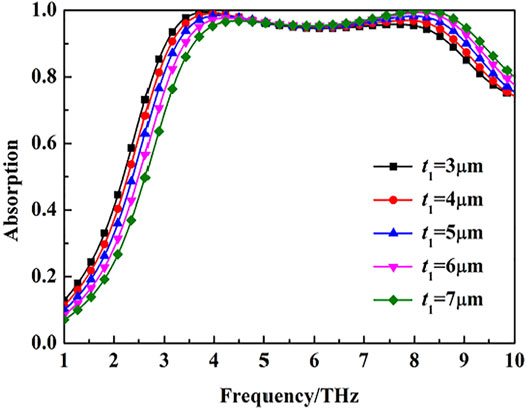
FIGURE 8. The absorption of the metamaterial absorber with different thickness of VO2 disk (T = 300 K).
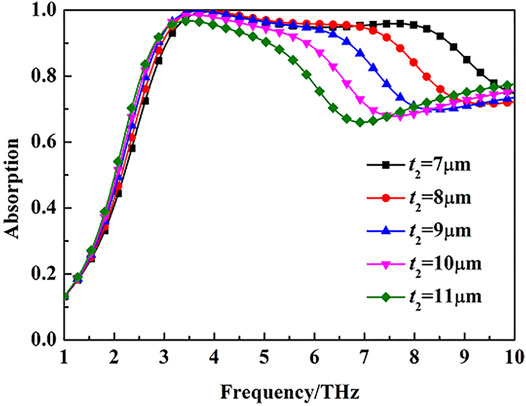
FIGURE 9. The absorption of the metamaterial absorber with different thickness of polyimide dielectric substrates (T = 300 K).
Conclusion
In conclusion, we propose a switchable ultra-wideband terahertz metamaterial absorber with polarization-insensitivity and wide-incident angle. It is composed of a VO2 disk, polyimide dielectric substrate, and gold ground plane. The simulation results show that the absorber provides a strong wideband absorption for incident waves from 3.5–8 THz for a temperature of 300 K and this strong absorption band diminishes when the temperature rises to 350 K. We also show that the absorption property of our proposed metamaterial absorber is insensitive to polarization states and angles and it responses well under wide-incident angles as well.
Data Availability Statement
The raw data supporting the conclusion of this article will be made available by the authors, without undue reservation.
Author Contributions
The contribution of QF is analysising the model. The contribution of DX, YW and XD is data processing.
Funding
This work is supported by Hainan Provincial Natural Science Foundation of China (Granted number: 620MS062).
Conflict of Interest
The authors declare that the research was conducted in the absence of any commercial or financial relationships that could be construed as a potential conflict of interest.
Publisher’s Note
All claims expressed in this article are solely those of the authors and do not necessarily represent those of their affiliated organizations, or those of the publisher, the editors and the reviewers. Any product that may be evaluated in this article, or claim that may be made by its manufacturer, is not guaranteed or endorsed by the publisher.
References
Argyropoulos, C., Le, K. Q., and Mattiucci, N. (2013). Broadband absorbers and selective emitters based on plasmonic Brewster metasurfaces. Phys. Rev. B. 87, 205112. doi:10.1103/physrevb.87.205112
Aydin, K., Ferry, V. E., Briggs, R. M., and Atwater, H. A. (2011). Broadband polarization-independent resonant light absorption using ultrathin plasmonic super absorbers. Nat. Commun. 2, 517. doi:10.1038/ncomms1528
Chen, H. T. (2012). Interference theory of metamaterial perfect absorbers. Opt. Express. 20, 7165–7172. doi:10.1364/oe.20.007165
Chen, K., Jia, N., Sima, B., Zhu, B., Zhao, J., and Feng, Y. (2015). Microwave absorber based on permeability-near-zero metamaterial made of Swiss roll structures. J. Phys. D: Appl. Phys. 48, 455304. doi:10.1088/0022-3727/48/45/455304
Chen, K., Luo, X., Ding, G., Zhao, J., Feng, Y., and Jiang, T. (2019). Broadband microwave metamaterial absorber with lumped resistor loading. EPJ Appl. Metamat. 6, 1. doi:10.1051/epjam/2018011
Costa, F., Monorchio, A., and Manara, G. (2010). Analysis and design of ultra-thin electromagnetic absorbers comprising resistively loaded high impedance surfaces. IEEE Trans. Antennas Propag. 58 (5), 1551–1558. doi:10.1109/tap.2010.2044329
Dao, R. N., Kong, X. R., Zhang, H. F., and Su, X. R. (2019). A tunable broadband terahertz metamaterial absorber based on the vanadium dioxide. Optik 180, 619–625. doi:10.1016/j.ijleo.2018.12.004
Ding, F., Cui, Y. X., Ge, X. C., Jin, Y., and He, S. L. (2012). Ultra-broadband microwave metamaterial absorber. Appl. Phys. Lett. 100, 103506. doi:10.1063/1.3692178
Dinh, M. Q., Huynh, T. V., Khuyen, B. X., Tung, B. S., Lam, V. D., Ngo, S. T., et al. (2021). Graphene-integrated hybridized metamaterials for wide-angle tunable THz absorbers. Photonic. nanostruct. 45, 100924. doi:10.1016/j.photonics.2021.100924
Fan, J., Xiao, D., Wang, Q., Liu, Q., and Ouyang, Z. (2017). Wide-angle broadband terahertz metamaterial absorber with a multilayered heterostructure. Appl. Opt. 56, 4388–4391. doi:10.1364/ao.56.004388
Hao, J., Lheurette, É., Burgnies, L., Okada, É., and Lippens, D. (2014). Bandwidth enhancement in disordered metamaterial absorbers. Appl. Phys. Lett. 105, 081102. doi:10.1063/1.4894181
He, X. J., Wang, Y., Wang, J. M., Gui, T. L., and Wu, Q. (2011). Dual-band terahertz metamaterial absorber with polarization insensitivity and wide incident angle. Prog.electromagn. res. 115, 381–397. doi:10.2528/pier11022307
Huang, M. L., Cheng, Y. Z., Cheng, Z. Z., Chen, H. R., Mao, X. S., and Gong, R. Z. (2018). Based on graphene tunable dual-band terahertz metamaterial absorber with wide-angle. Opt.commun. 415 (1), 194–201. doi:10.1016/j.optcom.2018.01.051
Huang, X., Lu, C., Rong, C., and Liu, M. (2018). Wide-angle perfect metamaterial absorbers based on cave-rings and the complementary patterns. Opt. Mater. Express. 8, 2520–2531. doi:10.1364/ome.8.002520
Huang, X. T., Lu, C. H., Rong, C. C., Hu, Z. Y., and Liu, M. H. (2018). Multiband ultrathin polarization-insensitive terahertz perfect absorbers with complementary metamaterial and resonator based on high-order electric and magnetic resonances. IEEE Photonics. J. 10 (6), 4600811. doi:10.1109/jphot.2018.2878455
Landy, N. I., Sajuyigbe, S., Mock, J. J., Smith, D. R., and Padilla, W. J. (2008). Perfect metamaterial absorber. Phys. Rev. Lett. 100, 207402. doi:10.1103/physrevlett.100.207402
Li, L., Yang, Y., and Liang, C. H. (2011). A wide-angle polarization-insensitive ultra-thin metamaterial absorber with three resonant modes. J. Appl. Phys. 110, 063702. doi:10.1063/1.3638118
Li, X. W., Liu, H. J., Sun, Q. B., and Huang, N. (2015). Ultra-broadband and polarization-insensitive wide-angle terahertz metamaterial absorber. Photonic. nanostruct. 15, 81–88. doi:10.1016/j.photonics.2015.04.002
Lin, X. Q., Mei, P., Zhang, P. C., Chen, Z. Z. D., and Fan, Y. (2016). Development of a resistor-loaded ultrawideband absorber with antenna reciprocity. IEEE Trans. Antennas Propagat. 64, 4910–4913. doi:10.1109/tap.2016.2598202
Quader, S., Akram, M. R., Xiao, F. J., and Zhu, W. R. (2020). Graphene based ultra-broadband terahertz metamaterial absorber with dual-band tunability. J. Opt. 22, 095104. doi:10.1088/2040-8986/aba814
Smith, D. R., and Schultz, S. (2002). Determination of negative permittivity and permeability of metamaterials from reflection and transmission coefficients. Phys. Rev. B 65, 195104. doi:10.1103/physrevb.65.195104
Son, T. B., Van, K. B., Van, D. N., Young, J. Y., Ki, W. K., Dinh, L. V., et al. (2014). Small-size metamaterial perfect absorber operating at low frequency. Adv. Nat. Sci. Nanosci. Nanotechnol. 5, 045008. doi:10.1088/2043-6262/5/4/045008
Wang, B.-X., Wang, L.-L., Wang, G.-Z., Huang, W.-Q., Li, X.-F., and Zhai, X. (2014). Theoretical investigation of broadband and wide-angle terahertz metamaterial absorber. IEEE Photon. Technol. Lett. 26 (2), 111–114. doi:10.1109/lpt.2013.2289299
Wang, B. X., Wang, L. L., Wang, G. Z., Huang, W. Q., and Zhai, X. (2014). Broadband, polarization-insensitive and wide-angle terahertz metamaterial absorber. Phys. Scripta 89 (11), 115501. doi:10.1088/0031-8949/89/11/115501
Xie, J. W., Quader, S., Xiao, F. J., He, C., Liang, X. L., Zhu, R. W., et al. (2019). Truly all-dielectric ultra-broadband metamaterial absorber: Water-based and ground-free. IEEE Trans. Antennas Propag. 18 (3), 536–540. doi:10.1109/lawp.2019.2896166
Xu, H. X., Wang, G. M., Qi, M. Q., Liang, J. G., Gong, J. Q., and Xu, Z. M. (2012). Triple-band polarization-insensitive wide-angle ultra-miniature metamaterial transmission line absorber. Phys. Rev. B 86, 205104. doi:10.1103/physrevb.86.205104
Zhang, H. B., Zhou, P. H., Lu, H. P., Xu, Y. Q., Liang, D. F., and Deng, L. J. (2013). Resistance selection of high impedance surface absorbers for perfect and broadband absorption. IEEE Trans. Antennas Propag. 61 (2), 976–979. doi:10.1109/tap.2012.2226225
Zhang, J., Wei, X. Z., Premaratne, M., and Zhu, W. R. (2019). Experimental demonstration of electrically tunable broadband coherent perfect absorber based on graphene-electrolyte-graphene sandwich structure. Photon. Res. 7 (8), 868–874. doi:10.1364/prj.7.000868
Zhang, J. Z., Li, Z. F., Shao, L. D., and Zhu, W. R. (2021). Dynamical absorption manipulation in a graphene-based optically transparent and flexible metasurface. Carbon 176, 374–382. doi:10.1016/j.carbon.2021.01.137
Keywords: ultra-wideband, metamaterial absorber, wide incident angle, THz band, switchable
Citation: Wang L, Xia D, Fu Q, Ding X and Wang Y (2021) A Switchable Ultra-Wideband Metamaterial Absorber with Polarization-Insensitivity and Wide-incident Angle at THz Band. Front. Mater. 8:729495. doi: 10.3389/fmats.2021.729495
Received: 23 June 2021; Accepted: 16 July 2021;
Published: 26 July 2021.
Edited by:
Ke Chen, Nanjing University, ChinaReviewed by:
Weiren Zhu, Shanghai Jiao Tong University, ChinaWang Shen-Yun, Nanjing University of Information Science and Technology, China
Copyright © 2021 Wang, Xia, Fu, Ding and Wang. This is an open-access article distributed under the terms of the Creative Commons Attribution License (CC BY). The use, distribution or reproduction in other forums is permitted, provided the original author(s) and the copyright owner(s) are credited and that the original publication in this journal is cited, in accordance with accepted academic practice. No use, distribution or reproduction is permitted which does not comply with these terms.
*Correspondence: Liansheng Wang, d2xzd2xzMTk4MkAxMjYuY29t
 Liansheng Wang
Liansheng Wang Dongyan Xia
Dongyan Xia Quanhong Fu
Quanhong Fu Xueyong Ding
Xueyong Ding Yuan Wang
Yuan Wang